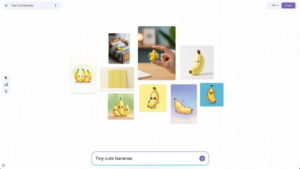
In an effort to play catch-up in the GenAI arms race, Google has launched Mixboard, a fresh AI-powered tool that transforms how ideas are visually brainstormed and developed. Developed by Google Labs, Mixboard combines generative AI with an open, interactive canvas to give users a seamless way to generate, organize, and refine visual concepts.
Google aims to use this new approach to moodboarding to speed up creativity by blending image generation, natural language editing, and contextual text creation into a single workspace.
Following its launch, Google’s Mixboard surpassed ChatGPT to reach the top spot in the U.S. App Store, driven by the viral success of its Nano Banana image editing feature, which transforms user photos into figurine-style portraits.
Mixboard was designed to allow users start with simple, freeform prompts, where they can describe the mood or look they want to explore. It is powered by Google’s Gemini 2.5 Flash, which means it has the power to autonomously create images, color palettes, layouts, and even contextual copies.
Users can adjust results from Mixboard with natural-language prompts like “make it more minimalist” or “blend these two concepts,” which can enable intuitive real-time editing without necessarily having traditional design skills.
Now competing with Pinterest, Mixboard can also reimagine and contribute ideas and will adapt to them based on user feedback. It is also designed to bridge gaps between early ideation and production.
For example, marketing teams can use the AI-powered tool to accelerate concept development and storyboarding by simultaneously developing imagery and messaging. For users who are interior designers, brand developers, or even event planners, Mixboard can offer them a playground for exploring aesthetics quickly.
Also compared to existing competitors, Mixboard’s integration of generative AI from the outset sets it apart. While Pinterest excels at organizing and remixing existing content, it lacks AI-driven generation and editing that can be woven into a creative process.
Mixboard, on the other hand, is capable of generating visuals, editing them via natural language, and going as far as generating accompanying text all in one space.
However, there is a caveat on the originality, copyright, and ownership of anything Mixboard generates. While Mixboard can produce compelling visuals, critics note that the outputs are generated by models trained on a large set of image data, which may create a real risk of Mixboard-results resembling existing works.
Ownership of AI-generated content remains legally murky, as contributors to training data are rarely credited. As such, this reality of AI claiming ownership of existing works raises legal and ethical questions.
Currently, Google says Mixboard is available in a public beta phase in the U.S. through Google Labs.

